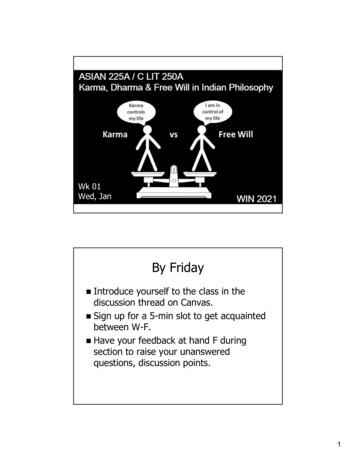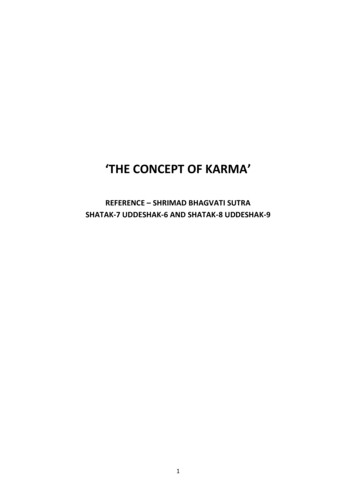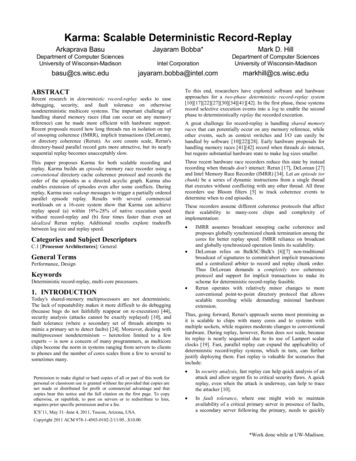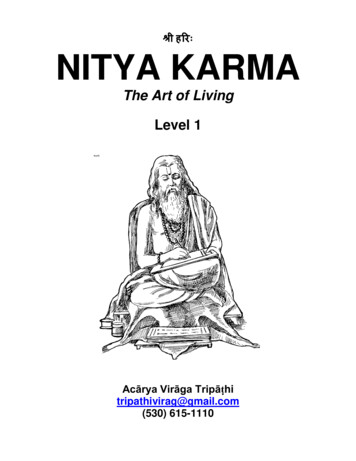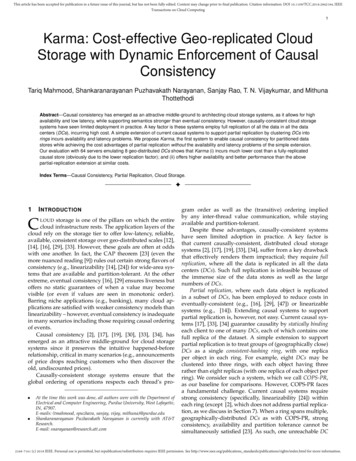
Transcription
This article has been accepted for publication in a future issue of this journal, but has not been fully edited. Content may change prior to final publication. Citation information: DOI 10.1109/TCC.2018.2842184, IEEETransactions on Cloud Computing1Karma: Cost-effective Geo-replicated CloudStorage with Dynamic Enforcement of CausalConsistencyTariq Mahmood, Shankaranarayanan Puzhavakath Narayanan, Sanjay Rao, T. N. Vijaykumar, and MithunaThottethodiAbstract—Causal consistency has emerged as an attractive middle-ground to architecting cloud storage systems, as it allows for highavailability and low latency, while supporting semantics stronger than eventual consistency. However, causally-consistent cloud storagesystems have seen limited deployment in practice. A key factor is these systems employ full replication of all the data in all the datacenters (DCs), incurring high cost. A simple extension of current causal systems to support partial replication by clustering DCs intorings incurs availability and latency problems. We propose Karma, the first system to enable causal consistency for partitioned datastores while achieving the cost advantages of partial replication without the availability and latency problems of the simple extension.Our evaluation with 64 servers emulating 8 geo-distributed DCs shows that Karma (i) incurs much lower cost than a fully-replicatedcausal store (obviously due to the lower replication factor); and (ii) offers higher availability and better performance than the abovepartial-replication extension at similar costs.Index Terms—Causal Consistency, Partial Replication, Cloud Storage.F1I NTRODUCTIONCLOUD storage is one of the pillars on which the entirecloud infrastructure rests. The application layers of thecloud rely on the storage tier to offer low-latency, reliable,available, consistent storage over geo-distributed scales [12],[14], [16], [29], [33]. However, these goals are often at oddswith one another. In fact, the CAP theorem [23] (even themore nuanced reading [9]) rules out certain strong flavors ofconsistency (e.g., linearizability [14], [24]) for wide-area systems that are available and partition-tolerant. At the otherextreme, eventual consistency [16], [29] ensures liveness butoffers no static guarantees of when a value may becomevisible (or even if values are seen in monotonic order).Barring niche applications (e.g., banking), many cloud applications are satisfied with weaker consistency models thanlinearizability – however, eventual consistency is inadequatein many scenarios including those requiring causal orderingof events.Causal consistency [2], [17], [19], [30], [33], [34], hasemerged as an attractive middle-ground for cloud storagesystems since it preserves the intuitive happened-beforerelationship, critical in many scenarios (e.g., announcementsof price drops reaching customers who then discover theold, undiscounted prices).Causally-consistent storage systems ensure that theglobal ordering of operations respects each thread’s pro- At the time this work was done, all authors were with the Department ofElectrical and Computer Engineering, Purdue University, West Lafayette,IN, 47907.E-mails: (tmahmood, spuzhava, sanjay, vijay, mithuna)@purdue.eduShankaranarayanan Puzhavakath Narayanan is currently with AT&TResearch.E-mail: snarayanan@research.att.comgram order as well as the (transitive) ordering impliedby any inter-thread value communication, while stayingavailable and partition-tolerant.Despite these advantages, causally-consistent systemshave seen limited adoption in practice. A key factor isthat current causally-consistent, distributed cloud storagesystems [2], [17], [19], [33], [34], suffer from a key drawbackthat effectively renders them impractical; they require fullreplication, where all the data is replicated in all the datacenters (DCs). Such full replication is infeasible because ofthe immense size of the data stores as well as the largenumbers of DCs.Partial replication, where each data object is replicatedin a subset of DCs, has been employed to reduce costs ineventually-consistent (e.g., [16], [29], [47]) or linearizablesystems (e.g., [14]). Extending causal systems to supportpartial replication is, however, not easy. Current causal systems [17], [33], [34] guarantee causality by statically bindingeach client to one of many DCs, each of which contains onefull replica of the dataset. A simple extension to supportpartial replication is to treat groups of (geographically close)DCs as a single consistent-hashing ring, with one replicaper object in each ring. For example, eight DCs may beclustered into three rings, with each object having threerather than eight replicas (with one replica of each object perring). We consider such a system, which we call COPS-PR,as our baseline for comparisons. However, COPS-PR facesa fundamental challenge. Current causal systems requirestrong consistency (specifically, linearizability [24]) withineach ring (except [2], which does not address partial replication, as we discuss in Section 7). When a ring spans multiple,geographically-distributed DCs as with COPS-PR, strongconsistency, availability and partition tolerance cannot besimultaneously satisfied [23]. As such, one unreachable DC2168-7161 (c) 2018 IEEE. Personal use is permitted, but republication/redistribution requires IEEE permission. See http://www.ieee.org/publications standards/publications/rights/index.html for more information.
This article has been accepted for publication in a future issue of this journal, but has not been fully edited. Content may change prior to final publication. Citation information: DOI 10.1109/TCC.2018.2842184, IEEETransactions on Cloud Computing2may render the entire system unavailable because the DC’sdata is unavailable to the clients bound to the DC’s ring.One may think that the above problem can be fixed byaccessing the unavailable data on a different ring. However,the single-ring binding is central to achieving causal consistency in current systems. To see why, consider two objects Xand Y that are each present in two rings with initial values,Xold and Yold . A client’s new values – Xnew and Ynew , inthat order – propagate to the two rings independently. If thesingle-ring restriction were not enforced, another client mayread Ynew from one ring and the causally-earlier Xold fromanother ring even though causal order within each ring ismaintained.The single-ring restriction degrades availability and latency. First, an object is unavailable if the replica in thatring is not reachable due to network partition or a failure ofthe DC hosting the replica, even though replicas in otherrings may be reachable. Second, a client is constrainedto accessing a replica in its associated ring, even thougha replica in another ring may offer lower latency due totransient network congestion.Our contributions: In this paper, we present Karma, the firstsystem that both ensures causal consistency and achieveshigh availability and low latency for partitioned data storeswith the cost advantages of partial replication across DCs.Karma employs two novel ideas: First, unlike previous causal systems, which staticallybind a client to its associated DC (or ring), Karma allowsa client to be served by any replica based on availability orlatency. Karma leverages the key observation that causalityis violated only in the time window from when a causallylater value is visible (Ynew ) until the causally-earlier value(Xnew ) is propagated to all the rings (i.e., becomes “stable”).Specifically, reads from multiple rings may be inconsistentonly in this short window (e.g., 300-400 ms is typical forthe geo-distributed 8 DCs in Amazon’s AWS). Accordingly,Karma temporarily restricts reads from a client to go to thesame ring as a previous read to an “in-flight” (i.e., as-yet notstable) data object. Because each ring is updated in causalorder (like the previous systems), this restriction guaranteesthat later reads obtain consistent values. Karma’s dynamicring restrictions (DRR) tracks in-flight objects to put thethreads reading such objects into the restricted mode andto release the threads to the unrestricted, full-choice modewhen the objects becomes stable. Because this restriction istransient, Karma mostly retains the choice of accessing anyring. Finally, because Karma allows ring-switching, it avoidsthe unavailability problem that may arise when DCs are notreachable. Second, Karma is the first system to integrate causal consistency across persistent DC-level storage caches and replicas.Integrating consistency guarantees across the storage andcaching tiers is one of the key challenges preventing adoption of stronger consistency models [1]. While all accessesgo to the local DC in full replication, many accesses go toremote DCs in partial replication (and in Karma). To achievelow latency with partial replication, it is natural to employboth read caching and temporary, persistent write bufferingat each DC. Write buffering and caching each pose their ownconsistency challenges. To avoid consistency problems dueto the write-buffer (WB), (1) we use thread-private WBs toprevent the premature reading of values by other threads(which can violate causal-order write propagation), and (2)we require client threads to check their own WBs to see ifreads can be satisfied from the WB before reading from thecache or storage ring to avoid missing own writes. Similarly,the cache poses a consistency challenge because it may missfor some objects (unlike storage rings which are guaranteedto be complete). For example, a client’s cache fill (upon amiss) bringing in the in-flight Ynew to a cache that holdsXold can violate consistency because (1) the same or (2) adifferent client may read Ynew followed by Xold . For thefirst case, we extend Karma’s DRR to force the clients, whoseread misses return in-flight values, to incur cache missestemporarily for all the reads in the in-flight window. Forthe second case, Karma allows demand fills only with stableobjects and not in-flight objects (the cached stable objectsare invalidated in causal order as part of write-propagation).These two simple strategies – forced temporary cache missesand disallowed demand fills – differ from conventionalcaching which does not force misses nor disallow demandfills and are fundamental to ensuring causality in Karma.We implemented Karma as a shim-layer between a keyvalue storage tier consisting of individual (unmodified)Cassandra instances and a YCSB client layer. Experimentalevaluation with 64 server nodes emulating 8 geo-distributeddata centers in 3 rings shows that Karma achieves 43%higher throughput on average and significantly lower readlatencies than COPS-PR, while incurring similar costs. Notethat Karma achieves lower performance than impractical fullreplication schemes where all accesses are local. However,that is not a specific weakness of Karma; rather it is innateto any partial replication scheme. Further, Karma offerssignificantly stronger availability guarantees under failure,and better performance under network congestion thanCOPS-PR. Finally, despite only partially replicating data,Karma guarantees full availability under a single availabilityzone [25], [38] failure, and many common network partitionmodes.The remainder of this paper is organized as follows.Section 2 defines the terminology we use and offers abrief background on consistency in cloud storage. Section 3and Section 4 describe Karma’s design and implementation,respectively. Section 5 explains our experimental methodology. We present experimental performance results and costanalysis in Section 6. Section 7 compares Karma to relatedwork. Finally, Section 8 concludes this paper.2BACKGROUND AND OPPORTUNITYIn this section we offer a brief background on consistency incloud storage and identify Karma’s opportunity. In doing so,we employ the following terms: Ring: A consistent-hashing ring contains a complete setof data. In causally-consistent cloud storage systems thatrequire full replication [2], [17], [19], [33], [34], the entirering is contained within a single DC. In partial replicationbased systems, however, a single ring may span multipleDCs. Replica: Each object (key-value pair) in the data set isreplicated in all the rings. Each such individual instance ofdata is referred to as a replica. Node: A physical server in the DC that stores data.2168-7161 (c) 2018 IEEE. Personal use is permitted, but republication/redistribution requires IEEE permission. See http://www.ieee.org/publications standards/publications/rights/index.html for more information.
This article has been accepted for publication in a future issue of this journal, but has not been fully edited. Content may change prior to final publication. Citation information: DOI 10.1109/TCC.2018.2842184, IEEETransactions on Cloud Computing3X 0Client 1Client 2put(X 1)put(Y)PP?PPq get(X) (returns X 1)?put(Z)Fig. 1. Inter and Intra thread causal dependencies2.1Consistency in cloud storageAmong the consistency models in cloud storage systemsare those limited to per-object guarantees. At the weakend of the consistency spectrum are flavors of “eventualconsistency” wherein the system offers no guarantees otherthan eventual propagation of updates to all copies. Eventualconsistency may not even guarantee read-your-own-writeordering guarantees; a thread may write a new value andthen read an older value. There also exist consistency models which offer stronger per-key ordering guarantees [12],[16], [21], but without any across-key guarantees (which isthe focus of this paper).At the strong end of the spectrum, linearizability offersglobal ordering of all reads and writes across all keys.However, it is well known that these strong consistencyguarantees come at the cost of availability and/or partitiontolerance (the CAP theorem [23]).2.2Causal ConsistencyCausal consistency is stronger than eventual consistencywith certain across-key ordering guarantees; yet it canachieve both consistency and availability under partition.Causal consistency is a model wherein the global orderingof operations respects each thread’s program order as wellas the (transitive) ordering implied by any cross-threadvalue communication [5], [17], [33], [36]. Writes in causalconsistency are not atomic (i.e., serializable) which meansthat causally-unrelated writes to different objects may beobserved to occur in different orders by different readers.For the special case of concurrent writes to the same object,the writes must be ordered deterministically, which can beachieved using version numbers [33]. The admission of lackof global agreement due to non-atomic writes allows causalconsistency not to be constrained by the CAP theorem sothat all three of causal consistency, availability and partitiontolerance can be achieved. For instance, upon a networkpartition, the two partitions can continue to be both causallyconsistent and available by allowing two different orderingsof causally-unrelated writes to co-exist in the partitions. Thewrites in one partition are not causally dependent on thevalues in the other because the latter is not reachable fromthe former due to the partition.Causality defines a happens-before partial order amongputs (writes) and gets (reads). In this paper, we use thenotation XY to imply that X happens-before Y . Asis intuitive, the happens-before partial order is transitive.A causality violation occurs when two operations are perceived to violate the happens-before relationship. Causalsystems track causal dependencies to ensure that reads andwrites cannot occur in an order that violates causality.The basic primitive to enforce such ordering in distributed storage systems is “put-after ” [33]. This operation ensures that causal ordering is enforced in each ringby initiating causally-later writes only after causally-earlierwrites are completed even though the items involved maybe stored on different servers (or DCs) in that ring. Forexample, in Figure 1, put Z is initiated only after both putX and put Y complete, though X, Y and Z may be storedon different servers.The updates occur in causal order in each ring, but proceed asynchronously across the rings. While this orderingprovides consistency within each ring, causality may beviolated by reading from different rings, as discussed inSection 1. For this critical reason, all current implementations statically bind clients to rings. Recall from Section1 that such static binding incurs availability and latencyproblems. While the latency problem is intuitive, one maythink that the availability problem can be addressed bychained replication (CR) [46]. CR is appropriate within DCsto ensure individual server availability, but does not protectagainst DC failures. However, using CR (which offers linearizability) across DCs in the wide area is impractical asthat would violate the CAP theorem.In the remainder of this paper, we assume a key-valuestore that allows puts and gets on individual tuples. Wedo not explicitly consider complex key-value store operations such as read-modify-write as they can be interpretedas puts for consistency purposes. Transactional atomicity isorthogonal to causal consistency which deals with ordering.Note that general transactions that include both reads andwrites are ruled out in a wide-area setting because of theCAP theorem. Some previous papers on causal consistencyhave also examined limited forms of transactional support(e.g., read-only [17], [33], [34], and write-only [34]) in addition to causal consistency as their motivating examplesrequire both atomicity and ordering. Because ordering isimportant on its own accord (as illustrated by our examples), we focus on causal consistency. However, we showlater in Section 4.5 that Karma can support read-only gettransactions by adopting the approach from prior work [34].2.3Karma’s opportunityKarma’s opportunity arises from the key observation thatstatically binding clients to rings, as in current systems, issufficient to ensure causal consistency; but is not necessary.To illustrate this point, consider the two states any objectmay be in. If an object has been written to (using a put)and the write is complete (i.e., all rings have been updatedwith the latest value) then the object is in a stable state. If onereplica of an object in one ring has been written to (and theasynchronous updates of the other replicas in other ringsare in progress) the object is in an in-flight state.When a client reads an in-flight value, the client isvulnerable to causality violations because causally-earlierwrites may not yet have been applied to all the rings; so theclient may later read a stale value from the not-yet-updatedrings. For example, in Figure 2, we show User A writing newvalues to X and Y in that order. As the values are propagated2168-7161 (c) 2018 IEEE. Personal use is permitted, but republication/redistribution requires IEEE permission. See http://www.ieee.org/publications standards/publications/rights/index.html for more information.
This article has been accepted for publication in a future issue of this journal, but has not been fully edited. Content may change prior to final publication. Citation information: DOI 10.1109/TCC.2018.2842184, IEEETransactions on Cloud Computing4Fig. 2. Karma’s opportunityto the two rings in causal order, it is possible for anotheruser (User B) to read a new value of Y from Ring 1 and anold value of X from Ring 2 — a causality violation. Karma’sgoal is to prevent such violations by binding User B to Ring1 as soon as it reads the in-flight value. No violations arepossible under that scenario because each ring is updatedin causal order, the chosen ring is guaranteed to providecausally-consistent values to later reads. Further, becausethe window of vulnerability is transient (i.e., writes willeventually complete), Karma applies this restriction onlyuntil the in-flight value becomes stable, as mentioned inSection 1. Upon write completion, the restrictions are lifted,and clients can access data from any ring. The fact thata client that has read only stable values (or has read inflight values that have since become stable) can not violatecausality is also illustrated in Figure 2 (see the second set ofreads from User B). This claim follows because all causallyearlier updates must necessarily be complete because ofcausal-order write-propagation in any given ring.Restrictions caused by a single in-flight read does notface cascading restrictions. However, if a user continuouslyreads multiple in-flight objects, the client restrictions canbe lifted only after all such in-flight writes are complete.Later in Section 6.3, we show that under typical read-heavyworkloads [4], [5], [12], [17], [33] (e.g., 95%:5% put-to-getratio), clients are rarely ( 2%) under such restrictions.3Karma: D ESIGN OVERVIEWSince partial replication results in remote accesses which canhurt latency, Karma attempts to minimize remote accessesvia the use of per-DC caches and persistent write-buffers(WBs). While the latency improvements from caches andWBs are attractive, the challenge of using these multipletiers while preserving consistency must be addressed carefully. Karma ensures that there are no ordering violations asvalues flow through the WBs, storage rings, and caches, aswe describe next.Karma’s goal is to achieve causal consistency by ensuringthat no causally-older value may be read after a causallynewer value has been read. Consider two put operations toobjects X and Y which previously had the values Xold andYold and which are updated by the put operations to havethe values Xnew and Ynew . If there is a causal dependencyYnew (say),between the two put operations with Xnewthen, Karma (any causally-consistent system) must ensurethat no client can read Ynew and then read Xold . Karmaachieves this overarching invariant by performing puts andgets as outlined below.Fig. 3. ’Get’ operation in Karma (* explained in Section 4.1.2)Write Operation: Newly written values enter the WBwhere values are held in thread order. The values areasynchronously propagated to the storage rings. Like priorcausal systems, Karma requires causal-order to be preservedwhen propagating writes across rings [17], [33]. This ensuresthat in any given ring, Xnew is stored before Ynew is stored.As part of write propagation to a ring, all the ring’s cachedcopies of the object are invalidated before writing to the ring.Read Operation: The get operation is performed asshown in Figure 3. To understand get operation, we consider three cases based on where objects are read from.In each case we show that Karma ensures that causality ismaintained.Read Case 1: Objects are read from the WB. Because valuesin the WB are invisible to other clients, there can be no othercausally-newer values outside the WB. Because causallynewer values may be present in the read client’s own WB,reads first check the WB before looking in the caches and/orstorage rings (step 1 in Figure 3). (The check in the WB isnot as simple as testing presence; we present this detail laterin Section 4.1.2.) In our example, if Ynew was read from theWB, then either Xnew will also be read from the WB (if Xnewhas not been propagated from the WB (step 2 in Figure 3),or Xnew will be read from a storage ring or a cache (if Xnewhas propagated to the ring or cache – steps 4, 5, and 6 inFigure 3).Read Case 2: Objects are read from the storage ring. In thestorage rings (i.e., if the object is not in the WB), there aretwo cases to consider (step 3 of Figure 3). In the first case,a client thread reads Ynew from the ith ring Ri (say) beforethe value is fully propagated to all other rings. In this case,Karma’s dynamic read restrictions (DRR) forces subsequentreads from the thread to access values only from ring Ri .Because Ynew was propagated to ring Ri in causal order,any causally-older values (including Xnew ) are guaranteedto be present in ring Ri (step 4). We refer to such threadsthat face dynamic read restrictions as DRR-bound threads.In the second case, a client thread reads Ynew after thevalue has been propagated to all rings. In this case, causalorder write propagation ensures that Xnew was previouslypropagated to all rings. Thus, the client may read X from thecache (step 5) or from any ring (step 6) and is guaranteedto see Xnew or newer values. As such, Karma looks in thecache, and serves the object from the cache (step 5) if it is ahit and from any storage ring (step 6) if it is a miss.Read Case 3: Objects are read from the cache. Caches can2168-7161 (c) 2018 IEEE. Personal use is permitted, but republication/redistribution requires IEEE permission. See http://www.ieee.org/publications standards/publications/rights/index.html for more information.
This article has been accepted for publication in a future issue of this journal, but has not been fully edited. Content may change prior to final publication. Citation information: DOI 10.1109/TCC.2018.2842184, IEEETransactions on Cloud Computing5pose consistency problems if they allow causally-later values of some objects to be brought into the cache while thereare earlier values of other objects present in the cache (e.g.,Ynew and Xold ). Mixing of old and new values can occureither in the cache (first case) or by accessing some objectsin the cache and others in the storage rings (second case).For the first case, new values may enter the cachethrough a traditional demand-fill where an object is broughtinto the cache upon a miss. To prevent mixing of new andold values through demand fills, we disallow the caching ofin-flight values that are brought in on demand fills. Thus,the caches hold only stable values which are invalidatedupon writes (in causal order), preventing mixing of causallyearlier and later values in the cache. In our example, ifYnew becomes stable and is brought into the cache, thenXold is guaranteed to have been invalidated. Note that thedisallowing is only during the in-flight window and doesnot prevent caching in the common case (shown later inSection 6.3).We address the second case by forcing temporary cachemisses during DRRs which ensure access to the DRRconstrained ring, preventing mixing accesses to the cacheand to the storage rings (step 4 in Figure 3). In our example,if an in-flight Ynew is read by a client, the client is putunder DRR forcing cache misses and forcing reads to theDRR-constrained ring which is guaranteed to have Xnew .These forced misses are only under DRRs which are temporary (during in-flight windows) permitting the benefits ofcaching the vast majority of time.In each of the above cases, Karma guarantees that itis impossible to read Xold after reading Ynew . In the nextsection, we describe Karma’s implementation to achieve theoperational behavior described above.4Karma: I MPLEMENTATIONFor ease of exposition, we first present Karma’s dynamicread restriction without caches in Sections 4.1 and 4.2, andthen add caches in Section 4.3. These sections assume faultfree operation to focus on Karma’s consistency mechanisms.In Section 4.4, we describe Karma’s fault-tolerance mechanisms and guarantees.4.1Dynamic ring binding in KarmaRecall from Section 1 that Karma dynamically tracks in-flightobjects to put the storage clients reading in-flight objects intothe restricted mode and to release the clients to the normal,full-choice mode when the objects becomes stable. Becauseobjects become stable when the corresponding write completes globally (i.e., in all the replicas), detecting globalwrite-completion is a key functionality of Karma. In contrast, prior causal systems enforce static client-ring bindingwhich requires detecting only local write-completion (i.e., inthe local ring). Karma’s other key functionality is dynamicread restriction. Accordingly, we describe in Section 4.1.2how Karma tracks objects’ in-flight state to detect writecompletion; and in Section 4.2 how Karma imposes temporary read restrictions.DC-2DC-3DC-1CCDC-4DC-6MM DSDC-5CCMM DSMM Middle ManCC Client CoordinatorDSDatastore(e.g. Cassandra)DC-8CCMM DSDC-7DC-8Fig. 4. Karma Architecture Overview4.1.1Basic architecture overviewFigure 4 illustrates Karma’s organization. We use any standalone key-value data store (DS) at each node. We assumethat the geo-clustered sets of DCs form one consistenthashing ring1 holding one full replica set of the data. In Figure 4, there are three rings, one for each of the US andWestern Europe, Asia and Australia, and Brazil; and theBrazilian ring is magnified to show some details discussedbelow.Karma requires per-client state (to track causal dependencies) and per-object state (to track in-flight versusstable status of individual objects). Karma employs a clientcoordinator (CC) to redirect client requests to the appropriateback-end servers much like other datastores including noncausal datastores such as Cassandra. We augment CC withthe additional responsibility of tracking per-client causalmeta-state. There can be multiple CCs per DC. The CC isresponsible for two major tasks. First, it is responsible forcausality-preserving write-propagation to all rings from thewrite-buffers and for satisfying the safety property of detecting write-completion. Second, the CC enforces temporaryrestrictions to ensure that causality is not violated in thewindow of vulnerability (Section 4.2).To track the per-object stable versus in-flight state,one may either provision per-object state (1 bit/object) orequivalently, use a set of in-flight objects. We introduce amodule in the storage layer called the middle man (MM)which holds per-object metastate; there is an MM for thereplica in each ring. Figure 4 shows a CC in Brazil interactingwith an MM for an object’s replica in each of the threerings. The MM and storage server can be co-located onthe same node so that the MM holds the metastate for thedata on the server. To prioritize modularity and separationof c
transient, Karma mostly retains the choice of accessing any ring. Finally, because Karma allows ring-switching, it avoids the unavailability problem that may arise when DCs are not reachable. Second, Karma is the first system to integrate causal consis-tenc


